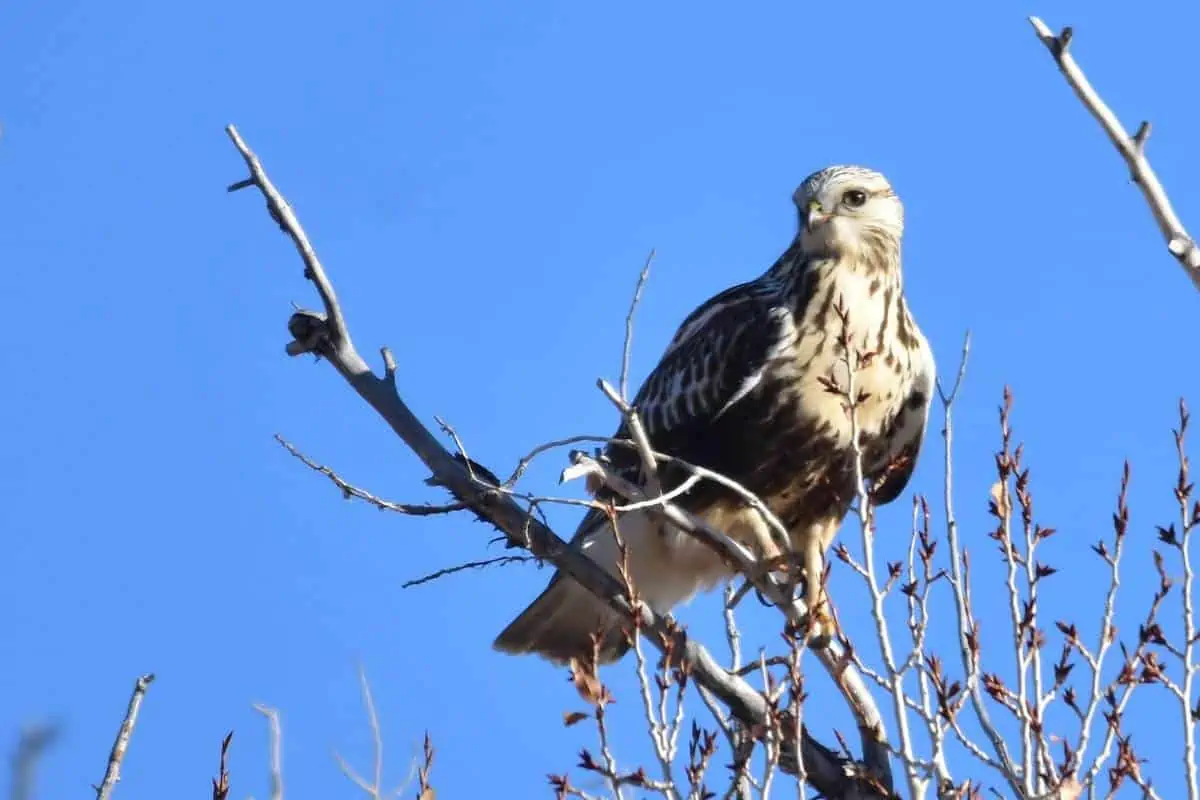The predators of the hawks are quite magnificent. Their keen hearing, sight, beak, and talons all contribute to their expertise as birds of prey. Humans have benefited from hawks’ hunting skills throughout history, through training and falconry. Throughout the United States, there are around 16 different kinds of hawks. However, we’ll talk about the eight different types of hawks in Connecticut in this article.
HAWKS IN CONNECTICUT
Broad-winged hawk, Coopers hawk, northern goshawk, northern harrier, red-tailed hawk, red-shouldered hawk, rough-legged hawk, and sharp-shinned hawk are the eight different species of hawks that live in Connecticut.
Let’s take a look at each one.
1. BROAD-WINGED HAWK
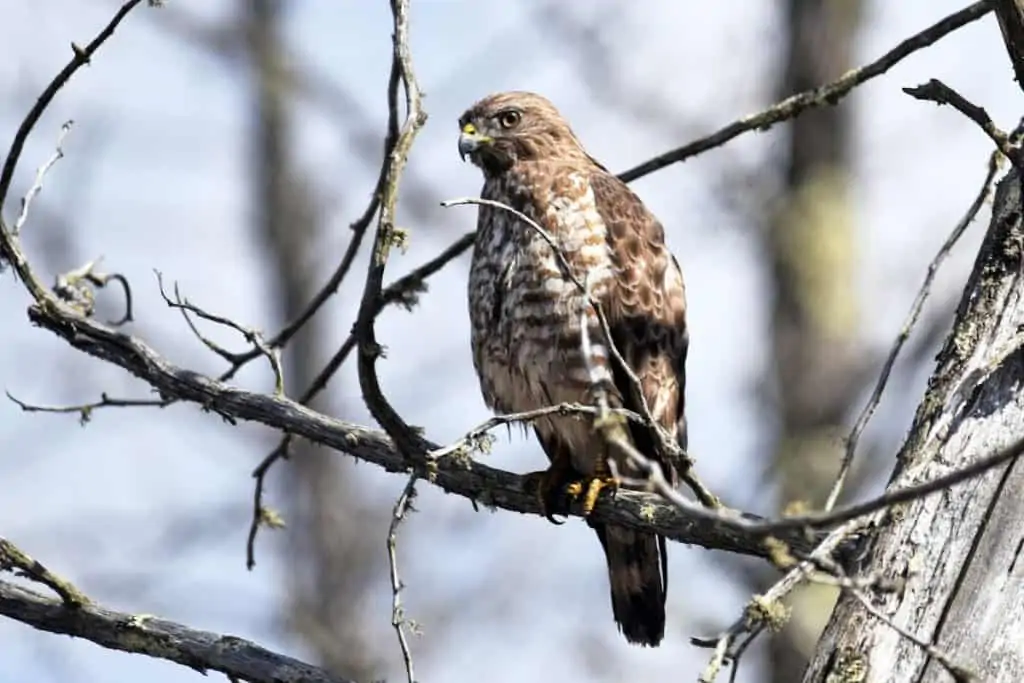
Scientific name: Buteo platypterus
Length: 13.4-17.3 in
Weight: 9.3-19.8 oz
Wingspan: 31.9-39.4 in
Only during the spring-summer breeding season do broad-winged hawks migrate north into Connecticut. The head and breast of these smaller hawks are brown, the underparts are barred, and the tail is black and white. Their small tail and broad wings with pointed tips are visible in flight.
During the breeding season, these hawks prefer to be in a secluded area. Far from humans, they will nest in woodlands and beside bodies of water. Little animals like frogs and toads, as well as insects and amphibians.
2. COOPERS HAWK
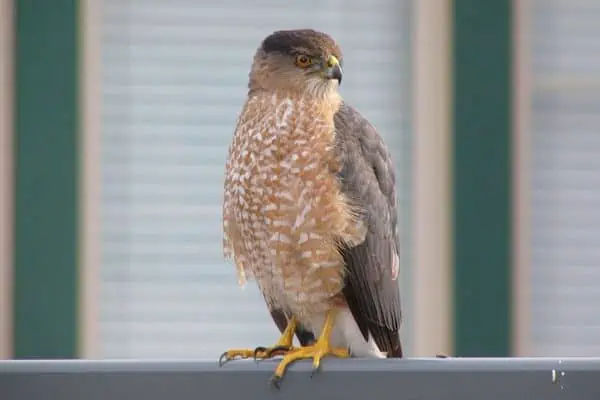
Scientific name: Accipiter cooperii
Length: 14.6 – 17.7 in
Weight: 7.8 – 24.0 oz
Wingspan: 24.4-35.4 in
Cooper’s hawks may be found year-round in Connecticut, and may be seen across most of North America. Adults have a red eye, a squared-off head with black cap, and a bluish-gray back with heavy orange barring on the chest. The eye of immature birds is yellow, and the back and head are brown with extensive brown streaks. The underparts are white with considerable brown streaks.
They prefer woodlands and forests, but they seem to be quite comfortable in the suburbs as well. Little birds are their primary food source, and they catch them with ease in the tree canopy. The Cooper’s hawk has been known to attack birds at a bird feeder, particularly starlings, doves, and pigeons, and many people have seen them in their backyard.
Many of Cooper’s hawk skeletons revealed that they had broken bones in their chest after colliding through trees and foliage on a high-speed chase after birds, according to studies.
3. NORTHERN GOSHAWK

Scientific name: Accipiter gentilis
Length: 20.9-25.2 in
Weight: 22.3-48.1 oz
Wingspan: 40.5-46.1 in
The back of the goshawk is gray, with a thick stripe over each eye and gray chest markings that extend all the way down the belly. The sharp-shinned and cooper’s hawk are considered their larger and fiercer cousins. Goshawks, on the other hand, are quite cautious and prefer to stay in the forest, avoiding human inhabited areas.
Except along the coast, where they may only be seen during non-breeding season, northern goshawks can be found year-round in Connecticut. Yet, since they prefer to nest in ancient woodland with deep canopy, it will be difficult for you to locate one. Humans who get too close to their nests have been known to be attacked. So, during the breeding season, be cautious when looking for these raptors.
Little hawks, birds, mammals, reptiles, and even insects and carrion make up the varied diet of the northern goshawk. Because of their secretive nature, they are considered uncommon and their population is difficult to determine.
4. NORTHERN HARRIER

Scientific name: Circus hudsonius
Length: 18.1-19.7 in
Weight: 10.6-26.5 oz
Wingspan: 40.2-46.5 in
The face of the northern harrier is nearly owl-like. This disc-shaped face, which looks like an owl, directs noise into the ears of these creatures so that they may both hear and see. The long tail and white patch above the tail are two helpful identifying features. Their wings are held in the shape of a “V”, which is their signature flying style. These birds are described as majestic in the context of their size.
During the breeding season, you may see this hawk in Connecticut, as well as throughout the year. They’re most often seen in marshes, fields, and such wide-open places.
This hawk creates a platform on the ground in dense vegetation, unlike many hawks that nest in trees. Males may have two (sometimes more) females at the same time, and they will feed both the mother and her offspring.
5. RED-TAILED HAWK
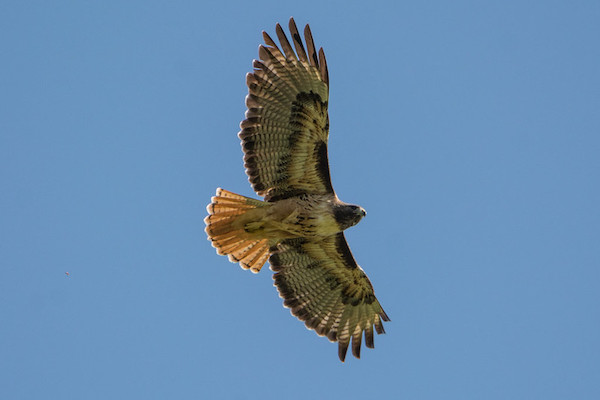
Scientific name: Buteo jamaicensis
Length: 17.7 – 25.6 in
Weight: 24.3oz – 51.5 oz
Wingspan: 44.9-52.4 in
On the North American continent, red-tailed hawks may be found in practically every state, including Connecticut, and may be found year-round. As birds that have spent their summer in Canada come down to join the others in the United States, their population increases even more during the winter.
Red-tailed hawks are often seen flying around looking for prey with their exceptional sight or perched on telephone poles along the highway in the day or early morning. Mice, rats, rabbits, and squirrels make up the majority of their diet. Birds and snakes are also possible foods.
While still juveniles, their tail is brown and white striped, whereas adults have a brick-red tail that is easy to identify. Below is pale, while above is dark brown.
Their breast is streaked with brown, and their belly region bears another distinguishing feature: a band of darker brown streaks that run across it. There are numerous color mutations across the country since these hawks are so widespread.
6.RED-SHOULDERED HAWK
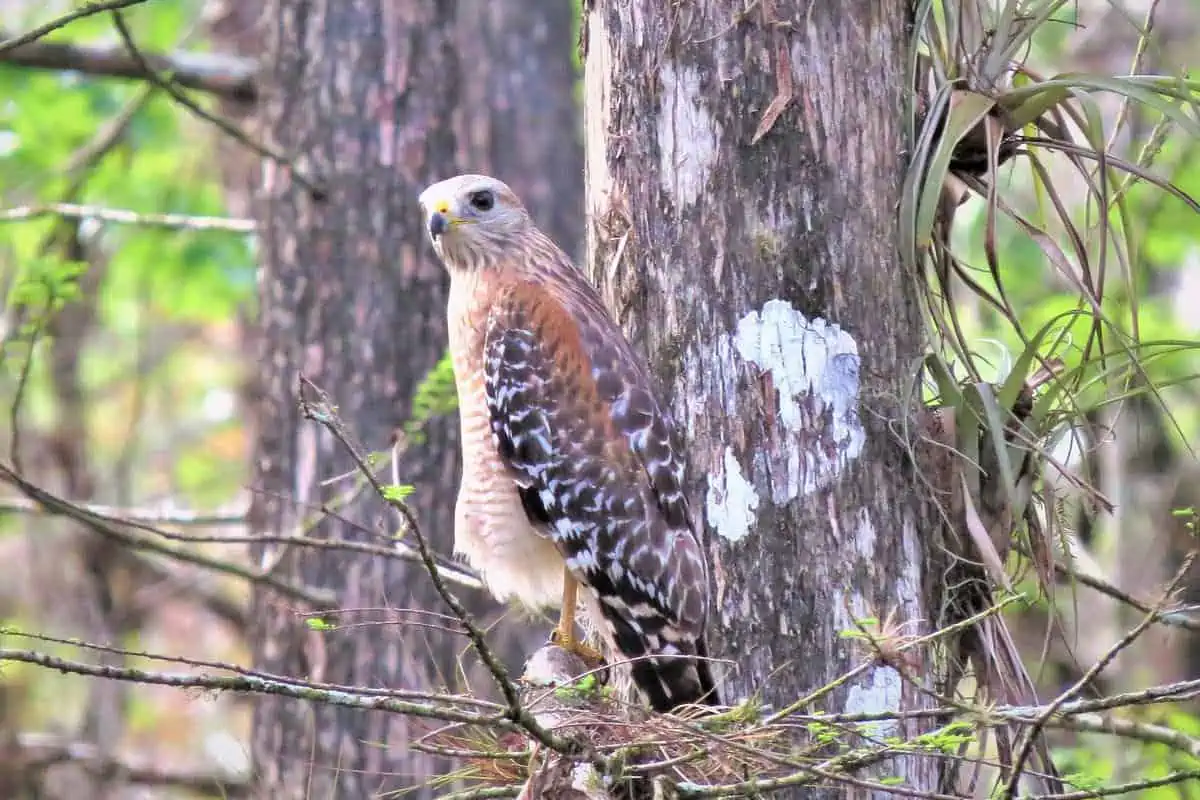
Scientific name: Buteo lineatus
Length: 16.9-24.0 in
Weight: 17.1-27.3 oz
Wingspan: 37.0-43.7
In their range, which spans the eastern United States, red-shouldered hawks are common. Together with the California coast, These are year-round residents of Connecticut.
The dense red coloring on the breast, which extends down their belly and has red barring down the center, is a helpful identifying characteristic. Their back and wings are covered in black feathers that are nearly black.
This will be blended with reddish feathers (thus the name) at the top of their back and “shoulders. A large amount of white barring will be intermingled with the black feathers from mid-back to the end of the tail, which will be heavily banded.
Before you can see it, you may hear this hawk. They emit a loud “kee-aah” call that is typically repeated numerous times in a row. Others believe it has a resemblance to a seagull. When startled, they will let out a loud cry to stake their claim.
These birds prefer flooded areas and wetlands, where they live and hunt in the forest. Suburban regions with wooded areas intermingled with buildings are also home to them. Although they are often confused with red-tailed hawks, once you know the distinctions, it is simple to tell them apart.
7. ROUGH-LEGGED HAWK

Scientific name: Buteo lagopus
Length: 18.5-20.5 in
Weight: 25.2-49.4 oz
Wingspan: 52.0-54.3 in
Throughout the fall and winter months, Connecticut is home to rough-legged hawks. They trek all the way to the northern Arctic when it comes time to move to their breeding grounds. They’ll breed on cliffs and rocky outcroppings there.
They can be found throughout the winter perching on poles and fence posts in open areas throughout the country. Mice, voles, and shrews are among the wildlife they hunt. Rough-legged hawks may use their wings to flap in place, achieving a hover-in-place position from which they may observe the ground beneath them for prey.
The feathers on rough-legged hawks’ legs give them their names. Feathers that extend down the legs of very few American raptors. The majority are dark brown with white splotches and a thick black belly patch. A black patch against a white backdrop will appear in the air as the wrist. A dark-morph looks two-toned from below and appears almost black.
8. SHARP-SHINNED HAWK

Scientific name: Accipiter striatus
Length: 9.4-13.4 in
Weight: 3.1-7.7 oz
Wingspan: 16.9-22.1 in
The smallest hawk in the United States, sharp-shinned hawks, lives in Connecticut year-round and is the state’s smallest falcon. Little birds and rodents are prey for these hawks, which pursue them through the woods.
They prefer to nest in forests with thick canopies, so finding them while nesting is difficult. Backyards are occasionally visited to hunt birds at feeders. During the fall migration, they’re easiest to spot. They go south of the border into the United States. These may be seen in large numbers at hawk watch sites from their summer range in Canada.
Sharp-shinned hawks have dark banding on their tails and a blue-gray back with reddish-orange barring on their breasts. They have a rounded head and squared-off tail, much like the cooper’s hawk.
